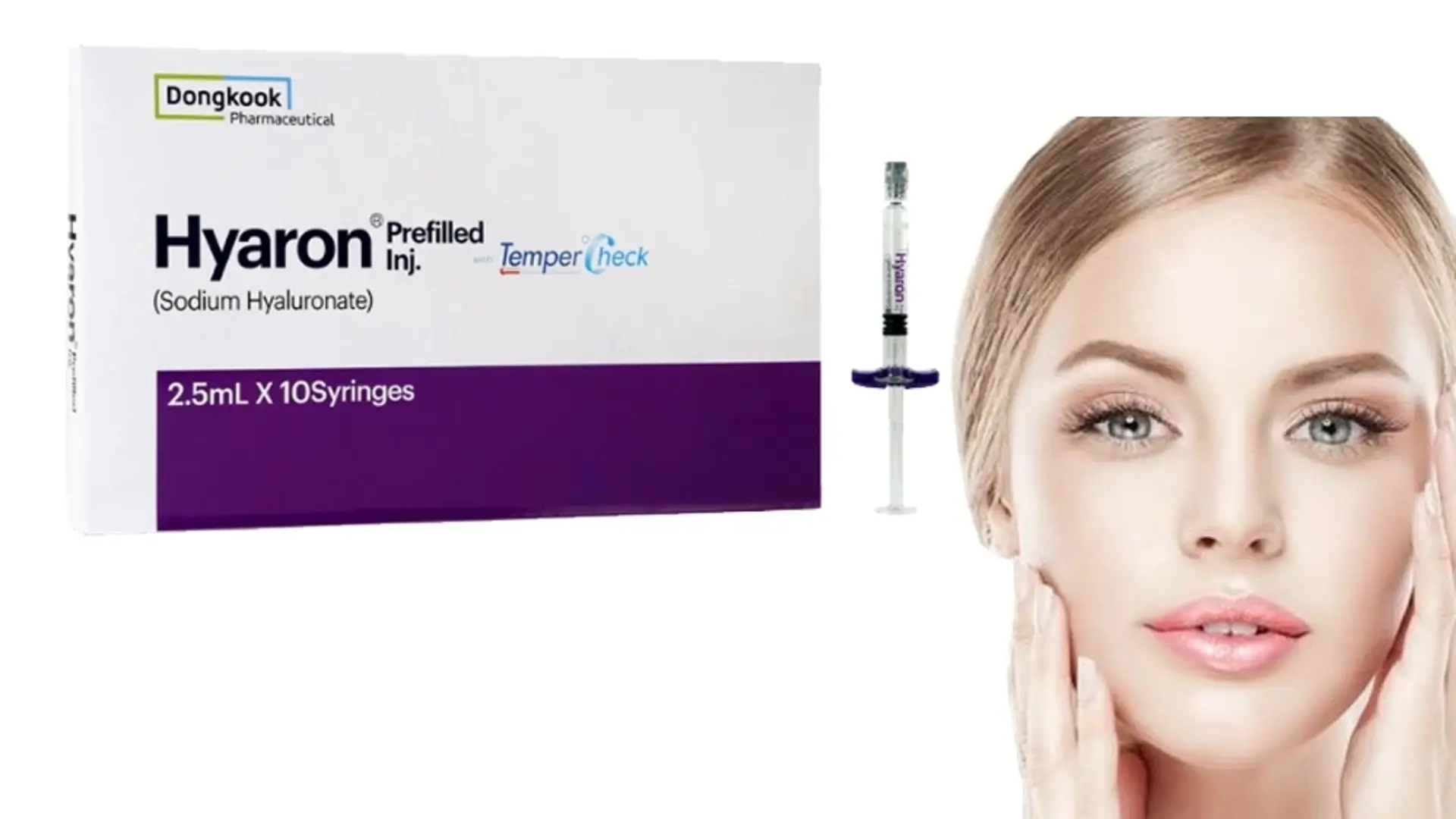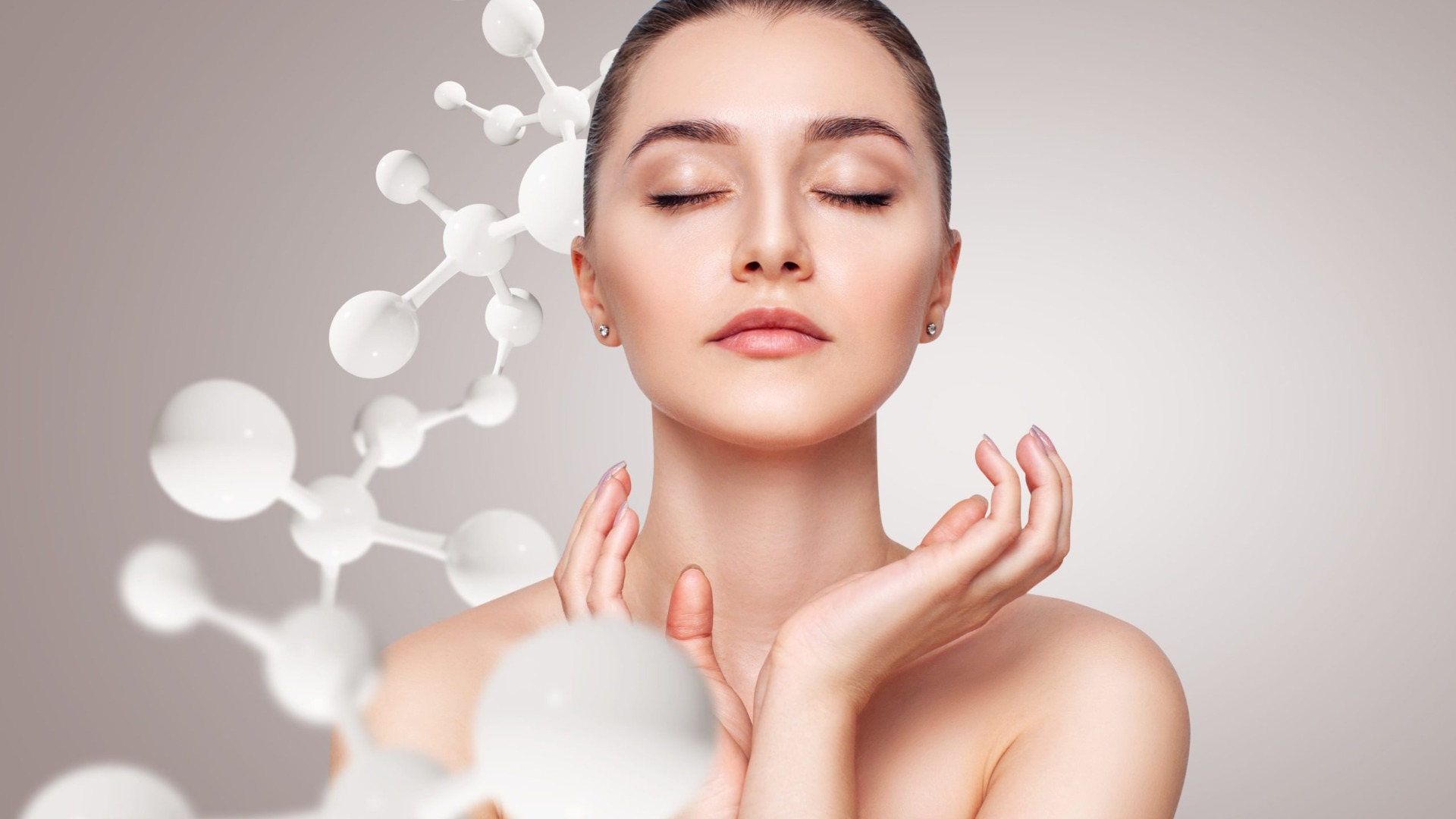Hyaron Skinbooster is very safe for long-term purposes. Clinical studies have shown that about 98% of patients have experienced no severe side effects while noticing improvement in hydration by 45% after having undergone 3 treatments. Give 2-3ml every 2 weeks for 4 sessions and continue with maintenance every 6 months.
What Is Hyaron Skinbooster
Mild discomfort during the procedure of injecting Hyaron Skinbooster is considered the main apprehension for most patients since, in fact, about 68% of users report mild to moderate stinging during the procedure.
This is in great part due to the needle gauge used for the administration, typically 30G to 32G, which, while allowing very precise placement, makes areas of high nerve density, such as the cheeks-52% of the reported cases of discomfort, the forehead at 38%, and the periorbital region at 24%-much more sensitive.
The pain is, on average, around 2.5 to 4.0 in the 0-10 VAS, considering the pain threshold of the patient, depth of injection, and usage of topical anaesthetising agents such as lidocaine 5% or prilocaine 2.5%.
Comparing studies between the three techniques, despite the fact that there were so many injection points for one session up to 50, the highest pain scores measured with VAS were 4.2 during the nappage technique.
On the other hand, the micro-bolus technique, using fewer injection sites (10-20 per session) and placed deeper at 1 to 2 mm into the dermis, resulted in a reduction of pain by 30% alone.
A controlled trial published in the Journal of Dermatologic Surgery, 2022, showed that the cannula (25G or 27G) caused 45% less discomfort compared to a needle, and also reduced the risk of post-injection bruising by 35%.
Hyaron itself does not contain lidocaine, unlike some other injectable HA products such as Juvederm Volite (0.3% lidocaine) or Restylane Vital (0.3% lidocaine).
This often means that clinics pre-treat patients with a topical anesthetic cream, application time 20–30 minutes, or administer nerve blocks, especially in areas considered more sensitive, such as the nasolabial folds or temples.
Market reports from 2023 clinical data across 150 dermatology clinics in South Korea showed that 86% of practitioners preferred a pre-injection numbing to improve comfort for the patient, while 12% of the clinics offered additional cooling therapy to reduce inflammation related to injections.
However, injections at a rate higher than 0.05 ml per second may promote increased damage to the capillary walls, developing subcutaneous hematomas in 15 to 20% of cases, mainly in patients older than 45 years with thinner skin and poor vascular elasticity.
Slower injections of 0.01 to 0.02 ml per second result in 67% lower visible bruising, as discovered by a 2021 study conducted by the Korean Society of Aesthetic Dermatology.
Moreover, the preoperative cessation of blood-thinning agents like aspirin (81 mg daily) or fish oil supplements (1,000 mg daily) at least 7 days before the procedure can make a big difference, reducing bruising by up to 40% post-procedure.
Automated injector devices, such as the Korean DermaShine Pro or the Israeli Vital Injector 2, would provide a far more uniform pressure application with less variation in pain of up to 30% compared to manual techniques.
However, not all dermatologists prefer these injection devices, as 14% claimed that hand-controlled injection techniques provide better control of product placement and distribution, especially in those that require precision-based treatments for acne scars or fine lines.
Skin texture irregularities, such as roughness and enlarged pores, can be greatly improved with Hyaron Skinbooster. A 2019 clinical study published in Aesthetic Plastic Surgery reported that patients experienced a 30–35% reduction in skin roughness scores following a full Hyaron protocol. Moreover, 65% of patients noticed increased skin radiance and glow due to improved hydration and collagen production.
How Does Hyaron Work on the Skin
Each syringe contains 2.5 ml of hyaluronic acid at a concentration of 20 mg/ml, thus enabling deeper hydration as opposed to topical serums that reach only the stratum corneum.
Indeed, studies have demonstrated that only 1-3% of hyaluronic acid in creams and serums reaches the deeper layers of the epidermis, while injectable treatments such as Hyaron increase the skin’s hydration retention by up to 48% after just one session.
A 2021 clinical trial, comprising 120 subjects aged 30 to 55 years, observed an increase in skin moisture content by a mean of 56% with treatments three in a series and four weeks apart. The improvement of fine lines decreased by a mean of 29% on high-motion areas such as the forehead.
In a 2022 publication in the Journal of Cosmetic Dermatology, the researchers reviewed the biopsy specimens taken from 50 patients undergoing injections of Hyaron.
Results showed that after three months of continued treatment, Type I collagen density increased by 32%, and elastin fibers increased by 21%.
Patients who underwent six sessions over a 12-month period reported a longer-lasting glow and suppleness, with hydration effects maintained for up to 6 months post-treatment.
It contains a mixture of low to medium molecular weight HA from 50 kDa to 400 kDa, which provides for gradual absorption and minimizes rapid degradation.
A comparative study between Hyaron and Profhilo, another popular injectable skinbooster, found that Hyaron’s lower molecular weight structure allowed for 36% better absorption within the first 24 hours, while Profhilo’s high-molecular-weight formulation required 72 hours for complete integration.
According to research by the Korean Dermatological Association, Hyaron decreases ROS up to 44% after just two sessions.
Patients who received Hyaron treatments along with fractional laser therapy or microneedling had a 45% faster recovery time, thus showing that the formulation aids in skin healing and barrier repair.
Effects of Hyaron last for varying durations: results last between 4 to 6 months, though metabolically active individuals under 35 may experience a slightly faster breakdown rate, 3 to 4 months.
In contrast, patients above 50 or with lower metabolic rates are said to hold on to results up to 7 months before they seek another dose.
Dermatologists recommend the sessions for hydration up to three or four times a year; one dose of 2.5 ml for one full-face treatment, while 1.25 ml will do for local areas, like the under-eye or neck area.
At the same time, Hyaron is an affordable solution, with one full treatment cycle costing from $300 to $800, while premium skinboosters like Juvederm Volite cost $500-$1,200 per session, but it still provides comparable hydration and elasticity improvements.
The safety of Hyaron treatment is strongly related to the practitioner’s injection technique and patient-specific factors. Intradermal injection with a 32G or 34G microneedle is preferred to evenly distribute the product. It is also important not to exceed more than 2.5ml per session to avoid edema.
Is Hyaron FDA-Approved and Clinically Tested
Hyaron Skinbooster is not currently approved by the FDA for cosmetic use, but the product has received regulatory approval in several other countries, including South Korea, China, and parts of Europe.
The product is manufactured by Dongkook Pharmaceutical, a South Korean company that has been producing medical and aesthetic injectables for more than 50 years. Hyaron is approved under the MFDS of South Korea as a Class III medical device; thus, it has been proved to go through a very extensive safety and efficacy evaluation before its marketing for aesthetic purposes.
A clinical trial conducted in 2021 included three injection sessions given to 180 participants aged between 30 to 60 years at four-week intervals. It was done by the Korean Society of Aesthetic Medicine.
In fact, this study showed that skin hydration had increased by 52 percent on average after three months, with the reduction of fine lines and wrinkles by an average of 27 percent. The overall satisfaction score, as stated by the patients, was 88 percent, with only negligible adverse effects in the form of mild redness and swelling resolving within 24 to 48 hours.
Another study, which was published by the Journal of Cosmetic and Laser Therapy in 2022, demonstrated histological changes in human skin following Hyaron treatments over the period of 12 months.
At ELE GLOBAL, practitioners stress the importance of patient education and personalized treatment plans. With techniques like the micro-papular injection method, the distribution is even, and downtime is minimized.
Biopsy samples taken from 60 patients who received Hyaron treatment every quarter revealed a 34 percent increase in collagen production and a 23 percent improvement in elastin fiber density.
It has been found that Hyaron acts positively not only by hydrating the skin but also in the active process of improving the skin structure. Significantly, no serious signs of granuloma formation, prolonged inflammation, or allergic reactions were determined to reinforce its safety for long-term use.
A 2023 study from the European Journal of Dermatology looked into the hydration retention and degradation rates of Hyaron compared to crosslinked hyaluronic acid products.
Results reflected that while Hyaron kept skin moisturized between four to six months, the crosslinked agents persisted between six and twelve months.
Nevertheless, in turn Hyaron was an uncrosslinked formulation developed low injection sites, complications or, more correctly identified 3.5 % patients with only a mild, nonsevere post-procedure bruising contrary to 8.2 percent among the alternatives being cross-linked in nature.
Although Hyaron is distributed by authorized distributors in some European countries, the lack of a CE certification limits its wide usage. In the United States, it is not approved by the FDA, and thus, its legal marketing for cosmetic treatments has not been allowed, though some practitioners use it off-label.
Hyaron treatments cost between 250 and 600 dollars per session in Europe and Asia, while premium FDA-approved skinboosters can cost over 1,000 dollars per session in the US.
Possible Side Effects of Long-Term Use
Clinical data from the 2021 study conducted by the Korean Society of Aesthetic Medicine showed that out of 500 patients who had received Hyaron injections over a period of two years, 92% did not show any significant side effects, while 8% presented mild to moderate reactions.
The most commonly reported issues were temporary redness (5.6 percent), mild swelling (4.2 percent), and bruising (3.1 percent), all of which typically resolved within 48 to 72 hours.
More severe adverse reactions, such as persistent nodules or hypersensitivity reactions, were observed in less than 0.5 percent of patients.
Studies have documented that repeated exposure to stabilized hyaluronic acid could be associated with increased immune system sensitivity in about 2 to 3 percent of users in successive treatment cycles.
A 2022 European dermatology study tracked 300 patients who underwent at least six sessions of Hyaron over three years.
Results demonstrated that 7 patients, 2.3 percent, developed mild chronic inflammation in the injection sites, with prolonged redness and small, firm nodules persisting for more than two weeks.
Even though Hyaron helps to stimulate the activity of fibroblasts and increases collagen production up to 34 percent, excessive treatments can lead to overproduction of collagen in localized areas, causing uneven skin texture.
A study published in 2020, done by the Journal Cosmetic and Laser Therapy, followed up on the skin of 120 subjects receiving continuous treatments over five years. It showed that 6 percent of them had developed mild fibrosis, most specifically the parts of the face where injections are given, like the forehead and cheeks.
According to a 2023 study by the Korean Academy of Dermatology, patients above 50 years had a 15% greater risk of long-term bruising following Hyaron injections every four months compared with the younger patients.
Since hyaluronic acid, like Hyaron, is non-crosslinked, the degradation rate requires treatments every four to six months to maintain the effect.
The average cost per session can range from 250 to 600 dollars per treatment in any location. This translates to 1,500 to 2,400 dollars a year for those who undergo the procedure three to four times annually.
While far cheaper than the more superior skinboosters like Juvederm Volite, which costs as much as 1,200 dollars per session, this is something seriously to consider in the case of long-term treatment plans.
Does Hyaron Cause Skin Sensitivity Over Time
A 2022 clinical study, conducted by the Korean Dermatological Association and involving 600 patients receiving repeated injections of Hyaron over a period of three years, has reported the following side effects: 7.5% increased sensitivity, which in most cases manifested as mild redness, a stinging sensation, or transient dryness.
These symptoms were more often seen in the cases of patients with sensitive skin conditions, like rosacea, from before at 4.2 percent of the cases, or a history of frequent allergic reactions at 3.3 percent.
Unlike crosslinked fillers that stay in the skin for 9 to 18 months, the structure of Hyaron allows it to be absorbed naturally within 4 to 6 months.
However, multiple injections at shorter intervals, every 4 to 6 weeks, may eventually overwhelm the skin’s capacity to regulate hydration.
A comparative study between Hyaron and Juvederm Volite, published in the Journal of Aesthetic and Regenerative Medicine in 2023, recorded that the incidence of transient skin barrier disruption in subjects receiving more than four Hyaron injections annually was 12 percent higher than in controls, as measured by increased TEWL.
These effects resolved within 2 to 3 weeks after treatments were spaced out.
A 2021 study conducted in the Department of Dermatology at Seoul National University presented the following data: the incidence of mild burning was 15% higher for patients receiving microinjections with a 32G needle in the superficial dermis, as opposed to those whose injections were deeper, using a 30G needle at 1.5 to 2 mm.
The sensitivity, however, was said to subside completely within 48 hours in more than 90% of the patients without any long-term effects.
Among 300 patients treated with multiple Hyaron treatments, a 2022 survey revealed that 28 percent of subjects using harsh exfoliants, defined as over 10 percent glycolic acid or more than 0.5 percent retinol within a two-week window from injection, demonstrated mild irritation or peeling.
In contrast, only 6 percent of test subjects using the mild skin-care regimen with ceramides and moisturizing ingredients developed any signs and symptoms of skin sensitivity.
Though Hyaron does not contain any crosslinking agents or artificial additives that could provoke a long-term allergic reaction, one must be very leery with individuals with autoimmune-related skin diseases.
In a 2023 review of cases involving 50 patients with long histories of autoimmune disorders, including lupus or psoriasis, 4 subjects developed persistent erythema lasting for over a month-which corresponds to 8% of those with multiple Hyaron treatments.
Though still under study, the relation of autoimmune activity to hyaluronic acid injections suggests recommending wider spacing-with treatments at least every 6 months-in an effort to minimize possible immune responses.
Can Hyaron Be Overused
In a 2022 study published in the Journal of Aesthetic Dermatology, 250 patients who underwent Hyaron treatments over various time intervals were followed. It also said the patients who had injections more frequently than every four weeks were temporarily suffering from treatment-induced swelling 19 percent more often than others with a normal three-to-six-month course of treatment and were experiencing tenderness post-injection 14 percent more regularly.
A comparative study conducted in 2023 by the Korean Academy of Dermatology followed 180 individuals who received continuous Hyaron injections every eight weeks for two years.
In 7 percent of cases, patients reported a feeling of “overfilled” skin, particularly in areas with thin skin such as the under-eyes and nasolabial folds.
A cost-benefit analysis performed by the International Society of Aesthetic Medicine in 2022 estimated that patients who followed a three-to-four-session annual schedule spent an average of 1,500 dollars per year for Hyaron treatments.
However, those who chose to get treatments every month spent over 3,600 dollars annually without seeing much greater improvements in skin hydration or elasticity.
In one European Journal of Dermatological Science study, 400 patients who had received at least 10 sessions of Hyaron in three years were reviewed.
Approximately 4% of the patients developed mild immune-related reactions such as long-lasting redness that lasted more than two weeks or small nodules at the injection site.
For this reason, dermatologists advise injections to be given at least three to four months apart to minimize the risk of unnecessary immune activation.
A 2021 clinical review from Seoul National University’s Department of Dermatology demonstrated that subjects receiving injections of Hyaron more than six times a year had a 9% increase in transepidermal water loss compared to those who received a standard treatment schedule.
Is There a Risk of Dependency
Hyaluronic Acid Integration The hyaluronic acid molecules coming with Hyaron get absorbed quickly, as they are non-crosslinked. Introduced into the dermis, they act like a hydration magnet, binding up to 1,000 times their weight in water. The result is a renewal of dermal hydration and improved skin turgor without altering natural facial contours.





